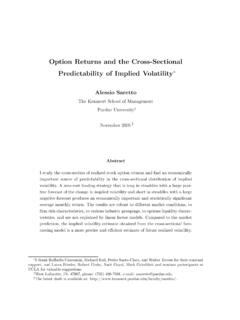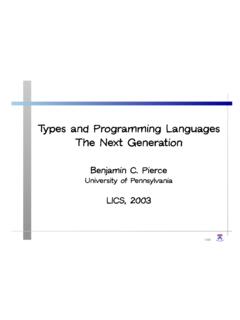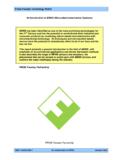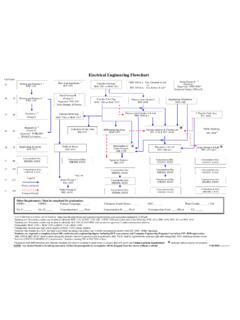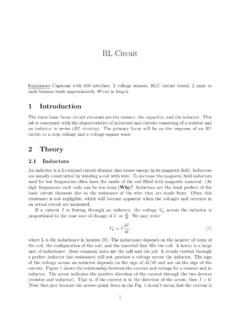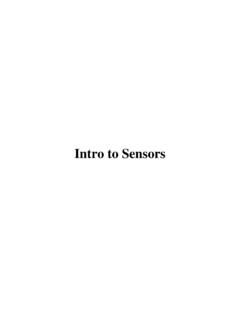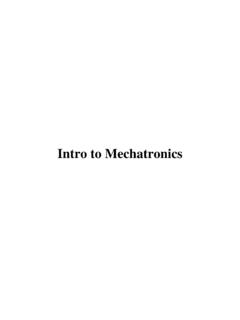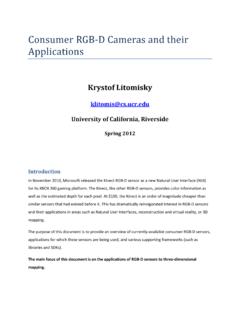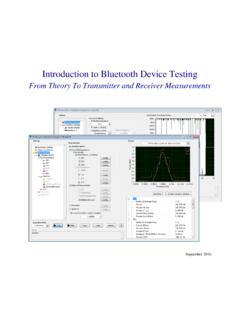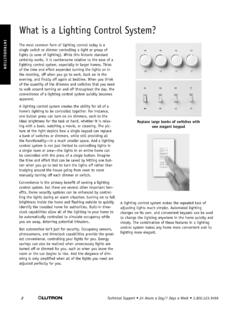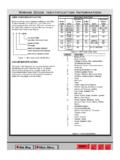Transcription of What is Computer Architecture?
1 CIS 501 (Martin): Introduction 1 CIS 501 Computer Architecture Unit 0: Introduction Slides developed by Milo Martin & Amir Roth at the University of Pennsylvania with sources that included University of Wisconsin slides by Mark Hill, Guri Sohi, Jim Smith, and David Wood. CIS 501 (Martin): Introduction 2 What is Computer Architecture? Computer Architecture is the science and art of selecting and interconnecting hardware components to create computers that meet functional, performance and cost goals. - WWW Computer Architecture Page An analogy to architecture of CIS 501 (Martin): Introduction 3 What is Computer Architecture? Plans The role of a building architect: Materials Steel Concrete Brick Wood Glass Goals Function Cost Safety Ease of Construction Energy Efficiency Fast Build Time Aesthetics Buildings Houses Offices Apartments Stadiums Museums Design Construction CIS 501 (Martin): Introduction 4 What is Computer Architecture? The role of a Computer architect: Technology Logic Gates SRAM DRAM Circuit Techniques Packaging Magnetic Storage Flash Memory Goals Function Performance Reliability Cost/Manufacturability Energy Efficiency Time to Market Computers Desktops Servers Mobile Phones Supercomputers Game Consoles Embedded Plans Design Manufacturing Important differences: age (~60 years vs thousands), rate of change, automated mass production (magnifies design) CIS 501 (Martin): Introduction 5 Computer Architecture Is Age of discipline 60 years (vs.)
2 Five thousand years) Rate of change All three factors (technology, applications, goals) are changing Quickly Automated mass production Design advances magnified over millions of chips Boot-strapping effect Better computers help design next generation CIS 501 (Martin): Introduction 6 Design Goals Functional Needs to be correct And unlike software, difficult to update once deployed What functions should it support (Turing completeness aside) Reliable Does it continue to perform correctly? Hard fault vs transient fault Google story - memory errors and sun spots Space satellites vs desktop vs server reliability High performance Fast is only meaningful in the context of a set of important tasks Not just Gigahertz truck vs sports car analogy Impossible goal: fastest possible design for all programs CIS 501 (Martin): Introduction 7 Design Goals Low cost Per unit manufacturing cost (wafer cost) Cost of making first chip after design (mask cost) Design cost (huge design teams, why?
3 Two ) (Dime/dollar joke) Low power/energy Energy in (battery life, cost of electricity) Energy out (cooling and related costs) Cyclic problem, very much a problem today Challenge: balancing the relative importance of these goals And the balance is constantly changing No goal is absolutely important at expense of all others Our focus: performance, only touch on cost, power, reliability CIS 501 (Martin): Introduction 8 Shaping Force: Applications/Domains Another shaping force: applications (usage and context) Applications and application domains have different requirements Domain: group with similar character Lead to different designs Scientific: weather prediction, genome sequencing First computing application domain: naval ballistics firing tables Need: large memory, heavy-duty floating point Examples: CRAY T3E, IBM BlueGene Commercial: database/web serving, e-commerce, Google Need: data movement, high memory + I/O bandwidth Examples: Sun Enterprise Server, AMD Opteron, Intel Xeon CIS 501 (Martin): Introduction 9 More Recent Applications/Domains Desktop: home office, multimedia, games Need: integer, memory bandwidth, integrated graphics/network?
4 Examples: Intel Core 2, Core i7, AMD Athlon Mobile: laptops, mobile phones Need: low power, integer performance, integrated wireless Laptops: Intel Core 2 Mobile, Atom, AMD Turion Smaller devices: ARM chips by Samsung and others, Intel Atom Embedded: microcontrollers in automobiles, door knobs Need: low power, low cost Examples: ARM chips, dedicated digital signal processors (DSPs) Over 1 billion ARM cores sold in 2006 (at least one per phone) Deeply Embedded: disposable smart dust sensors Need: extremely low power, extremely low cost CIS 501 (Martin): Introduction 10 Application Specific Designs This class is about general-purpose CPUs Processor that can do anything, run a full OS, etc. , Intel Core i7, AMD Athlon, IBM Power, ARM, Intel Itanium In contrast to application-specific chips Or ASICs (Application specific integrated circuits) Also application-domain specific processors Implement critical domain-specific functionality in hardware Examples: video encoding, 3D graphics General rules - Hardware is less flexible than software + Hardware more effective (speed, power, cost) than software + Domain specific more parallel than general purpose But general mainstream processors becoming more parallel Trend: from specific to general (for a specific domain) CIS 501 (Martin): Introduction 11 Constant Change.
5 Technology Technology Logic Gates SRAM DRAM Circuit Techniques Packaging Magnetic Storage Flash Memory Applications/Domains Desktop Servers Mobile Phones Supercomputers Game Consoles Embedded Absolute improvement, different rates of change New application domains enabled by technology advances Goals Function Performance Reliability Cost/Manufacturability Energy Efficiency Time to Market CIS 501 (Martin): Introduction 12 Technology Trends CIS 501 (Martin): Introduction 13 Technology Basic element Solid-state transistor ( , electrical switch) Building block of integrated circuits (ICs) What s so great about ICs? Everything + High performance, high reliability, low cost, low power + Lever of mass production Several kinds of IC families SRAM/logic: optimized for speed (used for processors) DRAM: optimized for density, cost, power (used for memory) Flash: optimized for density, cost (used for storage) Increasing opportunities for integrating multiple technologies Non-transistor storage and inter-connection technologies Disk, optical storage, ethernet, fiber optics, wireless channel source drain gate CIS 501 (Martin): Introduction 14 Technology Trends Moore s Law Continued (up until now, at least) transistor miniaturization Some technology-based ramifications Absolute improvements in density, speed, power, costs SRAM/logic: density: ~30% (annual), speed: ~20% DRAM: density: ~60%, speed: ~4% Disk: density: ~60%, speed.
6 ~10% (non-transistor) Big improvements in flash memory and network bandwidth, too Changing quickly and with respect to each other!! Example: density increases faster than speed Trade-offs are constantly changing Re-evaluate/re-design for each technology generation CIS 501 (Martin): Introduction 15 Technology Change Drives Everything Computers get 10x faster, smaller, cheaper every 5-6 years! A 10x quantitative change is qualitative change Plane is 10x faster than car, and fundamentally different travel mode New applications become self-sustaining market segments Recent examples: mobile phones, digital cameras, mp3 players, etc. Low-level improvements appear as discrete high-level jumps Capabilities cross thresholds, enabling new applications and uses CIS 501 (Martin): Introduction 16 Revolution I: The Microprocessor Microprocessor revolution One significant technology threshold was crossed in 1970s Enough transistors (~25K) to put a 16-bit processor on one chip Huge performance advantages: fewer slow chip-crossings Even bigger cost advantages: one stamped-out component Microprocessors have allowed new market segments Desktops, CD/DVD players, laptops, game consoles, set-top boxes, mobile phones, digital camera, mp3 players, GPS, automotive And replaced incumbents in existing segments Microprocessor-based system replaced supercomputers, mainframes , minicomputers , etc.
7 CIS 501 (Martin): Introduction 17 First Microprocessor Intel 4004 (1971) Application: calculators Technology: 10000 nm 2300 transistors 13 mm2 108 KHz 12 Volts 4-bit data Single-cycle datapath CIS 501 (Martin): Introduction 18 Pinnacle of Single-Core Microprocessors Intel Pentium4 (2003) Application: desktop/server Technology: 90nm (1/100x) 55M transistors (20,000x) 101 mm2 (10x) GHz (10,000x) Volts (1/10x) 32/64-bit data (16x) 22-stage pipelined datapath 3 instructions per cycle (superscalar) Two levels of on-chip cache data-parallel vector (SIMD) instructions, hyperthreading CIS 501 (Martin): Introduction 19 Tracing the Microprocessor Revolution How were growing transistor counts used? Initially to widen the datapath 4004: 4 bits ! Pentium4: 64 bits .. and also to add more powerful instructions To amortize overhead of fetch and decode To simplify programming (which was done by hand then) CIS 501 (Martin): Introduction 20 Revolution II: Implicit Parallelism Then to extract implicit instruction-level parallelism Hardware provides parallel resources, figures out how to use them Software is oblivious Initially using pipelining.
8 Which also enabled increased clock frequency .. caches .. Which became necessary as processor clock frequency increased .. and integrated floating-point Then deeper pipelines and branch speculation Then multiple instructions per cycle (superscalar) Then dynamic scheduling (out-of-order execution) We will talk about these things CIS 501 (Martin): Introduction 21 Pinnacle of Single-Core Microprocessors Intel Pentium4 (2003) Application: desktop/server Technology: 90nm (1/100x) 55M transistors (20,000x) 101 mm2 (10x) GHz (10,000x) Volts (1/10x) 32/64-bit data (16x) 22-stage pipelined datapath 3 instructions per cycle (superscalar) Two levels of on-chip cache data-parallel vector (SIMD) instructions, hyperthreading CIS 501 (Martin): Introduction 22 Modern Multicore Processor Intel Core i7 (2009) Application: desktop/server Technology: 45nm (1/2x) 774M transistors (12x) 296 mm2 (3x) GHz to Ghz (~1x) to Volts (~1x) 128-bit data (2x) 14-stage pipelined datapath ( ) 4 instructions per cycle (~1x) Three levels of on-chip cache data-parallel vector (SIMD) instructions, hyperthreading Four-core multicore (4x) CIS 501 (Martin): Introduction 23 Revolution III: Explicit Parallelism Then to support explicit data & thread level parallelism Hardware provides parallel resources, software specifies usage Why?
9 Diminishing returns on instruction-level-parallelism First using (subword) vector , Intel s SSE One instruction does four parallel multiplies .. and general support for multi-threaded programs Coherent caches, hardware synchronization primitives Then using support for multiple concurrent threads on chip First with single-core multi-threading, now with multi-core Graphics processing units (GPUs) are highly parallel Converging with general-purpose processors (CPUs)? To Is this decade s multicore revolution comparable to the original microprocessor revolution ? CIS 501 (Martin): Introduction 24 Technology Disruptions Classic examples: The transistor Microprocessor More recent examples: Multicore processors Flash-based solid-state storage Near-term potentially disruptive technologies: Phase-change memory (non-volatile memory) Chip stacking (also called 3D die stacking) Disruptive end-of-scaling If something can t go on forever, it must stop eventually Can we continue to shrink transistors for ever?
10 Even if more transistors, not getting as energy efficient as fast CIS 501 (Martin): Introduction 25 CIS 501 (Martin): Introduction 26 Recap: Constant Change Technology Logic Gates SRAM DRAM Circuit Techniques Packaging Magnetic Storage Flash Memory Applications/Domains Desktop Servers Mobile Phones Supercomputers Game Consoles Embedded Goals Function Performance Reliability Cost/Manufacturability Energy Efficiency Time to Market CIS 501 (Martin): Introduction 27 Managing This Mess Architect must consider all factors Goals/constraints, applications, implementation technology Questions How to deal with all of these inputs? How to manage changes? Answers Accrued institutional knowledge (stand on each other s shoulders) Experience, rules of thumb Discipline: clearly defined end state, keep your eyes on the ball Abstraction and layering CIS 501 (Martin): Introduction 28 Pervasive Idea: Abstraction and Layering Abstraction: only way of dealing with complex systems Divide world into objects, each with Interface: knobs, behaviors, knobs !

